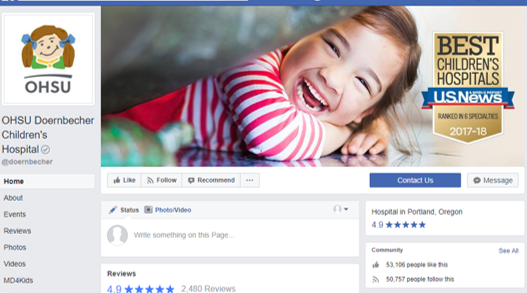Social media relies on personal networks to create narrow and focused ‘media’ broadcasts. Effective use of social media requires providing the right media to the most appropriate networks. As a professor and program leader at Oregon Health & Science University (OHSU), I have most frequently used three social media platforms to exchange unique sets of information important to our missions of healing, teaching and discovery: Twitter, LinkedIn and Facebook.
Starting Out
About six years ago, administrators at OHSU’s Doernbecher Children’s Hospital asked me to join a small cadre of faculty Twitter spokespersons. Since then, I have posted brief updates on hospital projects, department successes, published papers, educational events or new programs. This information now reaches over 1,700 followers from other departments and universities, corporate sponsors, students and trainees, community stakeholders and philanthropic donors. Local reporters also follow me, and on occasion source traditional media stories from our Twitter content.
Understanding that community members and donors are also interested in the personal qualities of medical leaders, I add Tweets about my non-professional travels, most scenic hikes, interesting books or great Oregon sunsets (a picture is worth more than 240 characters!). One donor who is very connected to our program opened a Twitter account simply so he could follow my feed, often responding to a Tweet he particularly enjoyed with a personal email, or even a mailed letter – a generational intersection that we both enjoyed.
 LinkedIn, founded by former Marshall Scholar Reid Hoffman, is the world’s principal social network for business. Many physicians use their LinkedIn profile as a digitally published, dynamic curriculum vitae. LinkedIn is a very effective platform for job searches, connecting clinical researchers, announcing advances and mobilizing professional networks. While the AANS member directory is a key resource for locating neurosurgeons, LinkedIn is a terrific way to reach out to potential collaborators at the American Association of Medical Colleges, American College of Surgeons, Accreditation Council for Graduate Medical Education or other professional organizations within or beyond medicine.
LinkedIn, founded by former Marshall Scholar Reid Hoffman, is the world’s principal social network for business. Many physicians use their LinkedIn profile as a digitally published, dynamic curriculum vitae. LinkedIn is a very effective platform for job searches, connecting clinical researchers, announcing advances and mobilizing professional networks. While the AANS member directory is a key resource for locating neurosurgeons, LinkedIn is a terrific way to reach out to potential collaborators at the American Association of Medical Colleges, American College of Surgeons, Accreditation Council for Graduate Medical Education or other professional organizations within or beyond medicine.
Read More
Why I am Not on Social Media
Prevent Online Disasters
Finally, the OHSU Department of Neurosurgery and OHSU Healthcare maintain patient and community-focused Facebook accounts that are critical to communication with our stakeholders. The Doernbecher Children’s Hospital Facebook page drives patient support groups, community networking and grassroots fundraising. As a clinician, I am most grateful for the patient and family support, groups testimonials, sincere thanks and strong encouragement found on our Facebook pages. These spontaneous outpourings of kindness to physicians represent authentic and heartfelt feedback that overshadows the results of patient satisfaction surveys.
In an increasingly complex and information-saturated world, social media allows me to craft my own message for the audiences that matter most to the missions of healing, teaching and discovery. Used properly, social media allows neurosurgeons to connect and serves as a reminder of the joy that grateful patients brings to our work.
[aans_authors]








